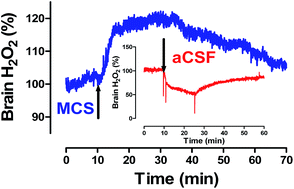In vivo characterisation of a catalase-based biosensor for real-time electrochemical monitoring of brain hydrogen peroxide in freely-moving animals†
Abstract
A catalase-based microelectrochemical biosensor developed for real-time neurochemical monitoring of hydrogen peroxide (H2O2) was characterised in freely-moving rats. The in situ sensitivity of the sensor was assessed by the direct delivery of H2O2 to the local environment of the implanted sensor and by the chemical manipulation of the endogenous concentration of H2O2. Inhibitors of H2O2 enzymatic degradation were utilised including sodium azide (SA) and mercaptosuccinate (MCS). SA and MCS primarily inhibit catalase and glutathione peroxidase (GPx) respectively and the application of each resulted in a significant increase in the H2O2 signal. The selectivity of the sensor was verified by the absence of a change in the signal in response to the peripheral administration of ascorbic acid (AA) compared to controls. Evidence of a disparity between brain H2O2 signalling in the freely-moving animal with respect to the anaesthetised subject was also observed. The enzymatic component of the paired H2O2 sensor was found to be stable over a continuous monitoring period of 12 days, thereby demonstrating the suitability of this sensor for the long-term chronic detection of brain H2O2.



 Please wait while we load your content...
Please wait while we load your content...